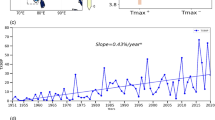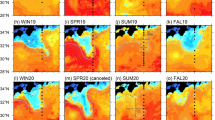Abstract
The regional features of the formation of extreme atmospheric and hydrological, climatic, and ecological regimes in connection with the manifestations of the Pacific Decadal Oscillation (PDO) against the background of the general warming of recent decades are estimated. In particular, the record Amur flood in 2013 and the Kamchatka “red tide” in 2020 were formed due to positive temperature anomalies in the western Pacific Ocean in the Northern Hemisphere, which corresponded to the negative PDO phase. Large-scale climatic variations, like the “climate shift” in the second half of the 1970s, are associated with PDO; their connection with the peculiarities of atmospheric blockings is noted. In particular, the frequency of summer atmospheric blockings, maximal over the European territory of Russia, is especially high during a negative PDO phase. The record-long atmospheric blocking period over the European Russia in summer 2010, with record heat and fires, fell precisely on a negative PDO phase.




Similar content being viewed by others
REFERENCES
Climate Change 2013: The Physical Science Basis. Contribution of Working Group I to the Fifth Assessment Report of the Intergovernmental Panel on Climate Change, Ed. by T. F. Stocker, D. Qin, G.-K. Plattner, (Cambridge University Press, Cambridge/New York, 2013).
I. I. Mokhov, Izv., Atmos. Ocean. Phys. 56 (4), 325–344 (2020).
V. G. Bondur, V. V. Zamshin, and O. I. Chvertkova, Dokl. Earth Sci. 497 (1), 255–261 (2021).
I. I. Mokhov, A. V. Chernokulsky, and A. M. Osipov, Russ. Meteorol. Hydrol. 45 (11), 749–762 (2020).
A. J. Miller, D. R. Cayan, T. P. Barnett, N. E. Craham, and J. M. Oberhuber, Oceanography 7, 21–26 (1994).
M. Latif and T. P. Barnett, J. Clim. 9, 2407–2423 (1996).
R. C. Wills, T. Schneider, J. M. Wallace, D. S. Battisti, and D. L. Hartmann, Geophys. Rev. Lett. 45, 2487–2496 (2018).
I. I. Mokhov, Dokl. Earth Sci. 455 (2), 459–462 (2014).
I. I. Mokhov, V. Ch. Khon, A. V. Timazhev, A. V. Chernokul’skii, and V. A. Semenov, in Extreme Flood Periods for Amur River Basin: Reasons, Predictions, Recommendations (Rosgidromet, Moscow, 2014), pp. 81–120 [in Russian].
T. Yu. Orlova, Vestn. Dal’nevost. Otd. Ross. Akad. Nauk, No. 1, 27–31 (2005).
R. C. Hooff and W. T. Peterson, Limnol. Oceanogr. 51 (6), 2607–2620 (2006).
S. M. McKibben, W. Peterson, A. M. Wood, V. L. Trainer, M. Hunter, and A. E. White, Proc. Nat. Acad. Sci. 114 (2), 239–244 (2017).
R. Corteґs-Altamirano, R. Alonso-Rodrıґguez, and D. A. Salas-de-Leoґn, PLoS ONE 14 (1), e020631 (2019). https://doi.org/10.1371/journal.pone.0210631
V. G. Bondur, I. I. Mokhov, O. S. Voronova, and S. A. Sitnov, Dokl. Earth Sci. 492 (1), 370–376 (2020).
I. I. Mokhov, V. G. Bondur, S. A. Sitnov, and O. S. Voronova, Dokl. Earth Sci. 495 (2), 921–924 (2020).
I. I. Mokhov, M. G. Akperov, M. A. Prokofyeva, A. A. Timazhev, A. R. Lupo, and H. Le Treut, Dokl. Earth Sci. 449 (2), 430–434 (2013).
A. R. Lupo, A. D. Jensen, I. I. Mokhov, A. Timazhev, T. Eichler, and B. Efe, Atmosphere 10 (2), 92 (2019). https://doi.org/10.3390/atmos10020092
I. I. Mokhov, A. V. Eliseev, and D. V. Khvorost’yanov, Izv., Atmos. Ocean. Phys. 36 (6), 681–691 (2000).
I. I. Mokhov, D. V. Khvorostyanov, and A. V. Eliseev, Int. J. Climatol. 24, 401–414 (2004).
S. Li, L. Wu, Y. Yang, T. Geng, W. Cai, B. Gan, Z. Chen, Z. Jing, G. Wang, and X. Ma Nat. Clim. Change 10, 30–34 (2020).
Funding
This work was supported by the Russian Science Foundation, project no. 19-17-00240. The features of the blocking conditions were analyzed under the financial support of the Ministry of Science and Higher Education of the Russian Federation, grant agreement no. 075-15-2020-776.
Author information
Authors and Affiliations
Corresponding author
Ethics declarations
The author declares that he has no conflicts of interest.
Additional information
Translated by O. Ponomareva
Rights and permissions
About this article
Cite this article
Mokhov, I.I. Extreme Atmospheric and Hydrological Phenomena in Russian Regions: Relationship with the Pacific Decadal Oscillation. Dokl. Earth Sc. 500, 861–865 (2021). https://doi.org/10.1134/S1028334X21100123
Received:
Revised:
Accepted:
Published:
Issue Date:
DOI: https://doi.org/10.1134/S1028334X21100123




